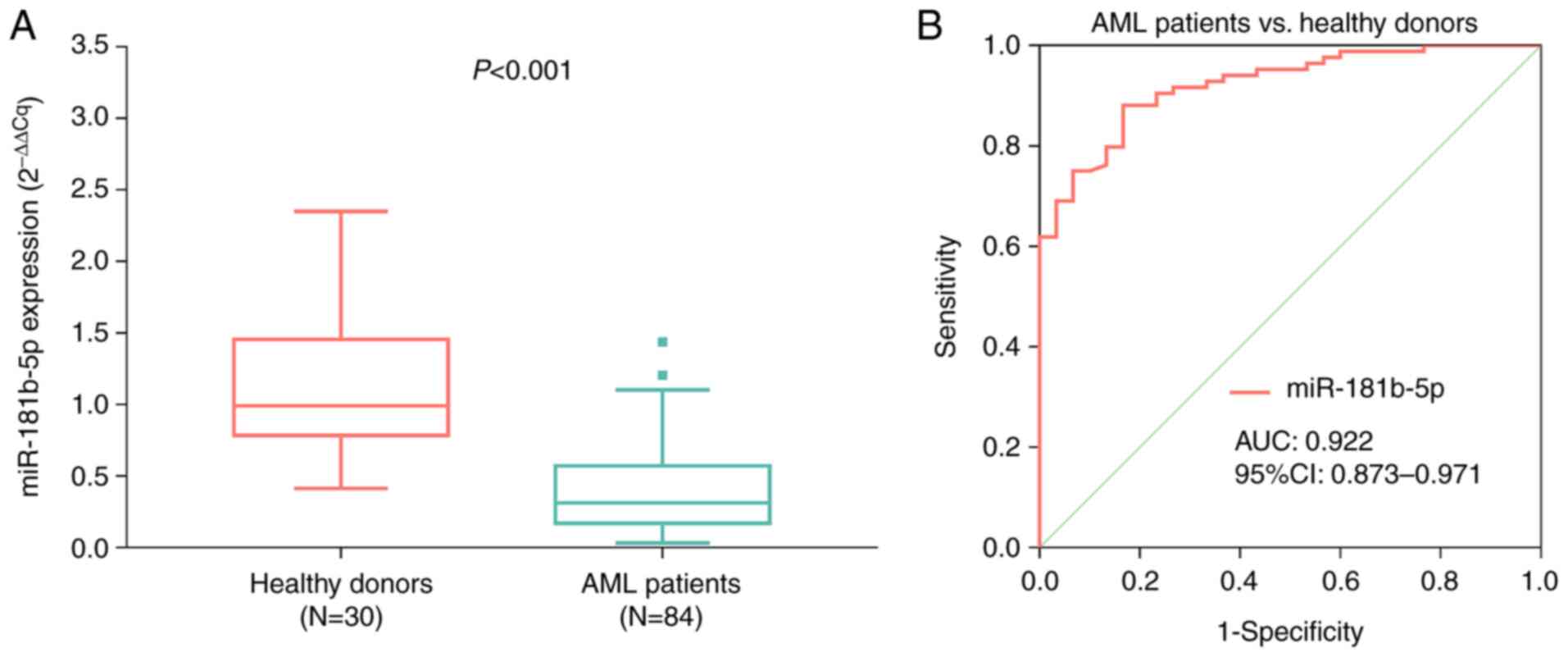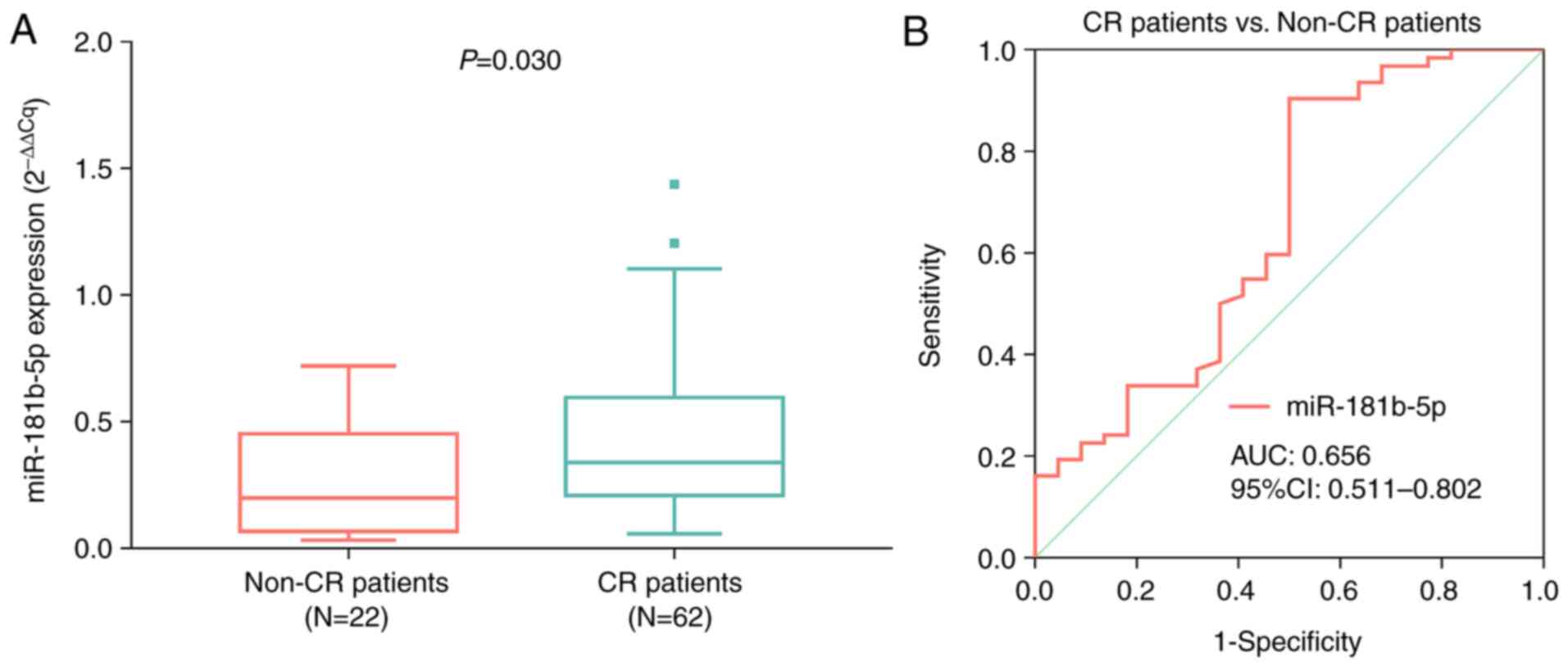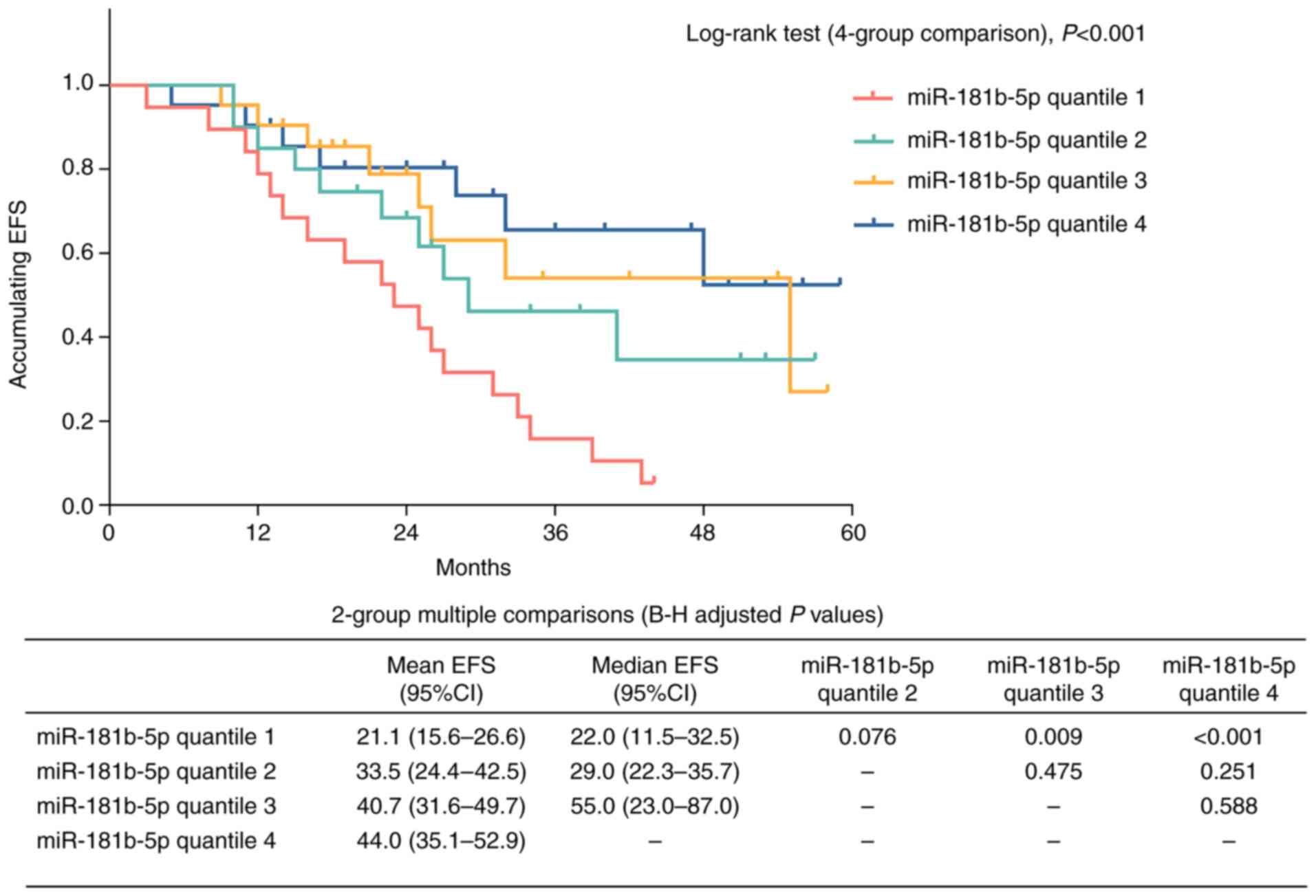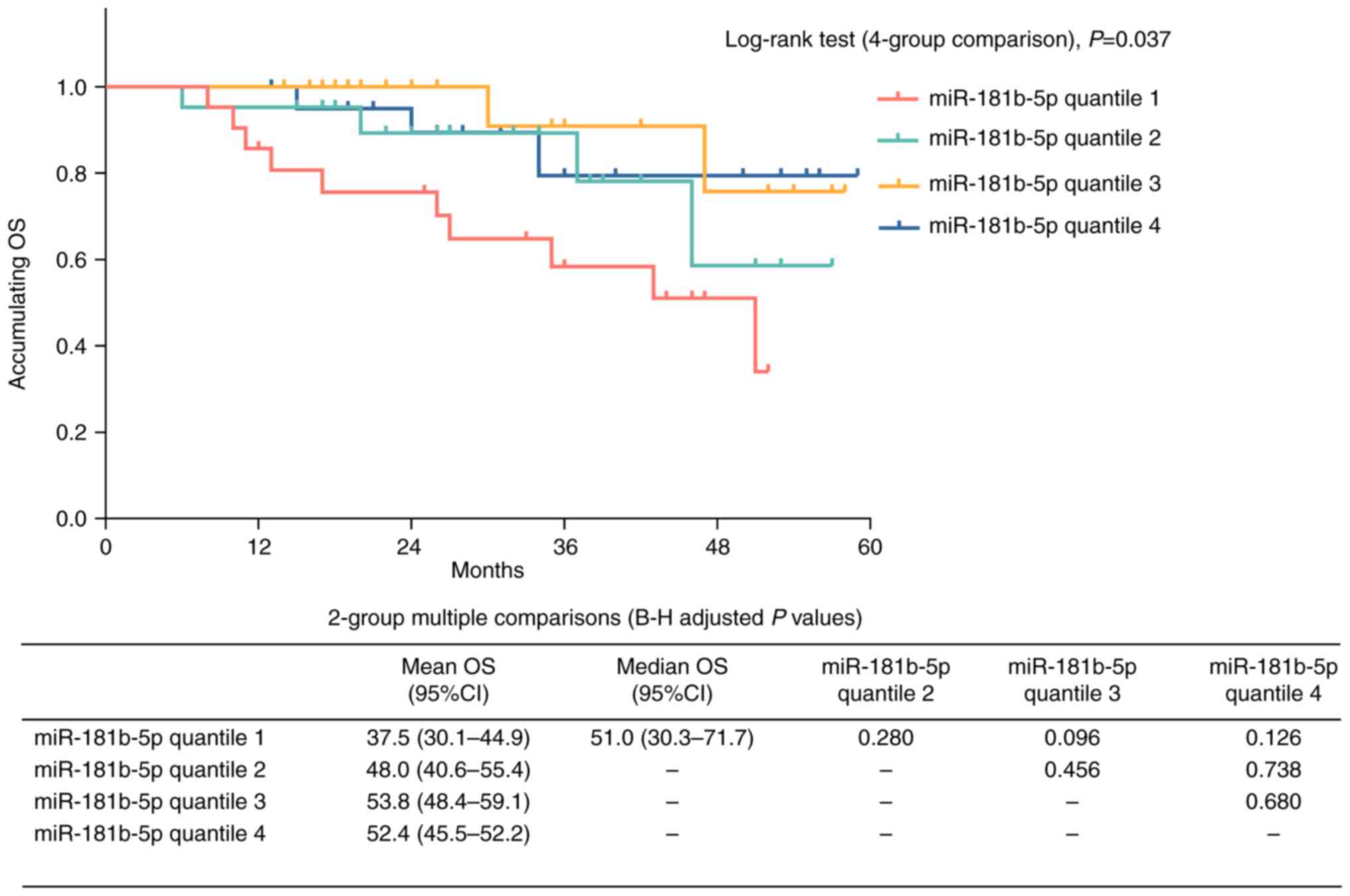|
1
|
Aquino VM: Acute myelogenous leukemia.
Curr Probl Pediatr Adolesc Health Care. 32:50–58. 2002. View Article : Google Scholar : PubMed/NCBI
|
|
2
|
Shipley JL and Butera JN: Acute
myelogenous leukemia. Exp Hematol. 37:649–658. 2009. View Article : Google Scholar
|
|
3
|
De Kouchkovsky I and Abdul-Hay M: ‘Acute
myeloid leukemia: A comprehensive review and 2016 update’. Blood
Cancer J. 6:e4412016. View Article : Google Scholar : PubMed/NCBI
|
|
4
|
Malfuson JV, Konopacki J, Thepenier C,
Eddou H, Foissaud V and de Revel T: Fractionated doses of
gemtuzumab ozogamicin combined with 3 + 7 induction chemotherapy as
salvage treatment for young patients with acute myeloid leukemia in
first relapse. Ann Hematol. 91:1871–1877. 2012. View Article : Google Scholar
|
|
5
|
Mika T, Ladigan S, Schork K, Turewicz M,
Eisenacher M, Schmiegel W, Schroers R and Baraniskin A:
Monocytes–neutrophils-ratio as predictive marker for failure of
first induction therapy in AML. Blood Cells Mol Dis. 77:103–108.
2019. View Article : Google Scholar : PubMed/NCBI
|
|
6
|
Papaemmanuil E, Gerstung M, Bullinger L,
Gaidzik VI, Paschka P, Roberts ND, Potter NE, Heuser M, Thol F,
Bolli N, et al: Genomic classification and prognosis in acute
myeloid leukemia. N Engl J Med. 374:2209–2221. 2016. View Article : Google Scholar : PubMed/NCBI
|
|
7
|
Yendamuri S and Calin GA: The role of
microRNA in human leukemia: A review. Leukemia. 23:1257–1263. 2009.
View Article : Google Scholar
|
|
8
|
Lu F, Zhang J, Ji M, Li P, Du Y, Wang H,
Zang S, Ma D, Sun X and Ji C: miR-181b increases drug sensitivity
in acute myeloid leukemia via targeting HMGB1 and Mcl-1. Int J
Oncol. 45:383–392. 2014. View Article : Google Scholar
|
|
9
|
Li Z, Huang H, Li Y, Jiang X, Chen P,
Arnovitz S, Radmacher MD, Maharry K, Elkahloun A, Yang X, et al:
Up-regulation of a HOXA-PBX3 homeobox-gene signature following
down-regulation of miR-181 is associated with adverse prognosis in
patients with cytogenetically abnormal AML. Blood. 119:2314–2324.
2012. View Article : Google Scholar : PubMed/NCBI
|
|
10
|
Seipel K, Messerli C, Wiedemann G, Bacher
U and Pabst T: MN1, FOXP1 and hsa-miR-181a-5p as prognostic markers
in acute myeloid leukemia patients treated with intensive induction
chemotherapy and autologous stem cell transplantation. Leuk Res.
89:1062962020. View Article : Google Scholar : PubMed/NCBI
|
|
11
|
Saadi MI, Arandi N, Yaghobi R, Azarpira N,
Geramizadeh B and Ramzi M: Aberrant expression of the
miR-181b/miR-222 after hematopoietic stem cell transplantation in
patients with acute myeloid leukemia. Indian J Hematol Blood
Transfus. 35:446–450. 2019. View Article : Google Scholar : PubMed/NCBI
|
|
12
|
Xiang L, Li M, Liu Y, Cen J, Chen Z, Zhen
X, Xie X, Cao X and Gu W: The clinical characteristics and
prognostic significance of MN1 gene and MN1-associated microRNA
expression in adult patients with de novo acute myeloid leukemia.
Ann Hematol. 92:1063–1069. 2013. View Article : Google Scholar
|
|
13
|
Livak KJ and Schmittgen TD: Analysis of
relative gene expression data using real-time quantitative PCR and
the 2(−Delta Delta C(T)) method. Methods. 25:402–408. 2001.
View Article : Google Scholar : PubMed/NCBI
|
|
14
|
Liu B, Guo Z and Gao W: miR-181b-5p
promotes proliferation and inhibits apoptosis of hypertrophic scar
fibroblasts through regulating the MEK/ERK/p21 pathway. Exp Ther
Med. 17:1537–1544. 2019.PubMed/NCBI
|
|
15
|
Dohner H, Estey EH, Amadori S, Appelbaum
FR, Büchner T, Burnett AK, Dombret H, Fenaux P, Grimwade D, Larson
RA, et al: Diagnosis and management of acute myeloid leukemia in
adults: Recommendations from an international expert panel, on
behalf of the European LeukemiaNet. Blood. 115:453–474. 2010.
View Article : Google Scholar : PubMed/NCBI
|
|
16
|
Su R, Lin HS, Zhang XH, Yin XL, Ning HM,
Liu B, Zhai PF, Gong JN, Shen C, Song L, et al: MiR-181 family:
Regulators of myeloid differentiation and acute myeloid leukemia as
well as potential therapeutic targets. Oncogene. 34:3226–3239.
2015. View Article : Google Scholar : PubMed/NCBI
|
|
17
|
Weng H, Lal K, Yang FF and Chen J: The
pathological role and prognostic impact of miR-181 in acute myeloid
leukemia. Cancer Genet. 208:225–229. 2015. View Article : Google Scholar
|
|
18
|
Soares-Lima SC, Pombo-de-Oliveira MS and
Carneiro FRG: The multiple ways Wnt signaling contributes to acute
leukemia pathogenesis. J Leukoc Biol. 108:1081–1099. 2020.
View Article : Google Scholar
|
|
19
|
Ruan Z, Lu L, Zhang L and Dong M: Bone
marrow stromal cells-derived microRNA-181-containing extracellular
vesicles inhibit ovarian cancer cell chemoresistance by
downregulating MEST via the Wnt/beta-catenin signaling pathway.
Cancer Gene Ther. 28:785–798. 2021. View Article : Google Scholar : PubMed/NCBI
|
|
20
|
Strotbek M, Schmid S, Sanchez-Gonzalez I,
Boerries M, Busch H and Olayioye MA: miR-181 elevates Akt signaling
by co-targeting PHLPP2 and INPP4B phosphatases in luminal breast
cancer. Int J Cancer. 140:2310–2320. 2017. View Article : Google Scholar : PubMed/NCBI
|
|
21
|
Fragoso R, Mao T, Wang S, Schaffert S,
Gong X, Yue S, Luong R, Min H, Yashiro-Ohtani Y, Davis M, et al:
Modulating the strength and threshold of NOTCH oncogenic signals by
mir-181a-1/b-1. PLoS Genet. 8:e10028552012. View Article : Google Scholar
|
|
22
|
Nepstad I, Hatfield KJ, Gronningsaeter IS
and Reikvam H: The PI3K-Akt-mTOR signaling pathway in human acute
myeloid leukemia (AML) cells. Int J Mol Sci. 21:29072020.
View Article : Google Scholar
|
|
23
|
Liu Q, Li W, Zhou Y, Jian J, Han S, Liu C,
Li W, Zhu X, Ma D, Ji M and Ji C: PRKD2 promotes progression and
chemoresistance of AML via regulating notch1 pathway. Onco Targets
Ther. 12:10931–10941. 2019. View Article : Google Scholar : PubMed/NCBI
|
|
24
|
Abu-Duhier FM, Goodeve AC, Wilson GA, Gari
MA, Peake IR, Rees DC, Vandenberghe EA, Winship PR and Reilly JT:
FLT3 internal tandem duplication mutations in adult acute myeloid
leukaemia define a high-risk group. Br J Haematol. 111:190–195.
2000. View Article : Google Scholar
|
|
25
|
Niktoreh N, Walter C, Zimmermann M, von
Neuhoff C, von Neuhoff N, Rasche M, Waack K, Creutzig U, Hanenberg
H and Reinhardt D: Mutated WT1, FLT3-ITD, and NUP98-NSD1 fusion in
various combinations define a poor prognostic group in pediatric
acute myeloid leukemia. J Oncol. 2019:16091282019. View Article : Google Scholar
|
|
26
|
Larson RA: Micro-RNAs and copy number
changes: New levels of gene regulation in acute myeloid leukemia.
Chem Biol Interact. 184:21–25. 2010. View Article : Google Scholar
|
|
27
|
Marcucci G, Radmacher MD, Maharry K,
Mrózek K, Ruppert AS, Paschka P, Vukosavljevic T, Whitman SP,
Baldus CD, Langer C, et al: MicroRNA expression in cytogenetically
normal acute myeloid leukemia. N Engl J Med. 358:1919–1928. 2008.
View Article : Google Scholar : PubMed/NCBI
|
|
28
|
Pollyea DA, Bixby D, Perl A, Bhatt VR,
Altman JK, Appelbaum FR, de Lima M, Fathi AT, Foran JM, Gojo I, et
al: NCCN guidelines insights: Acute myeloid leukemia, version
2.2021. J Natl Compr Canc Netw. 19:16–27. 2021. View Article : Google Scholar : PubMed/NCBI
|
|
29
|
Chen CZ, Li L, Lodish HF and Bartel DP:
MicroRNAs modulate hematopoietic lineage differentiation. Science.
303:83–86. 2004. View Article : Google Scholar : PubMed/NCBI
|



















